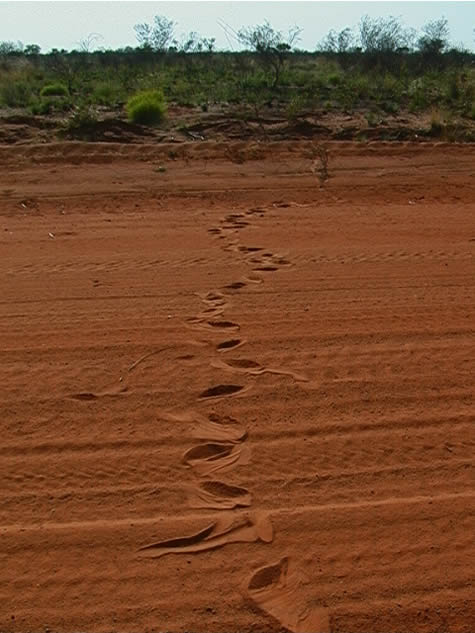2001 September 25, Tuesday. Twenty kilometres north of the Tanami Gold Mine, on the Lajamanu Track.
We’re one of the few creatures out here which are about in the day time. Because of the relentless solar radiation in daylight hours, most animals are active at night, and we can tell that we’re sharing their space only because of the pattern of footprints, tail prints, and belly prints left in the soft red sand.

These trails have captured our imaginations from the white silica sands of the Starcke mangrove swamps, through the riverbeds of the dividing range. They have been our entertainment when wading for miles through the deep sand of private station roads, and have made pleasant surprises when, after travelling on bitumen, we discover them amongst the brush during rest breaks.
We are able, by now, to match most of the tracks we encounter to their makers. The most exciting way to learn this is by having seen the animal actually making its trail, as with our close encounter with a long green snake today. But besides the interesting things to know about animals are living out here, tracks can be useful – to us, to native bush people, and to other animals.
Station owners can recognise foreign vehicle tracks and know strangers have been on their land. Chappie, the musterer we met one morning earlier in the trip told us that he had seen our tracks the night before, and “knew there were some crazy nutters on bikes out here.”
Mammal tracks can often be followed to a water source, as they cannot travel great distances in the desert without drinking regularly. To an animal with a less developed sense of sight than humans, tracks of another kind would be as obvious as footprints are to us.
Dingoes, for example, could follow a marsupial using scent or footprints, and sneak up upon it to hunt it as food. In the same way, a creature who sits much lower on the food chain, such as a rodent, could detect the presence of a threatening animal through it’s scent, and escape predation.
Suggestions: Some animals leave deliberate ‘trails’ of scent to mark their territories. Perhaps you have noticed your family pet doing this. What other trails could let you know there were animals about? Can you find any tracks in your local area which have been left by native or domestic animals? If so, try to find out who left them. Think about why that animal might have been going where it was. Think about the footprints you leave everywhere you go - how could you disguise these tracks to prevent being followed?
bel